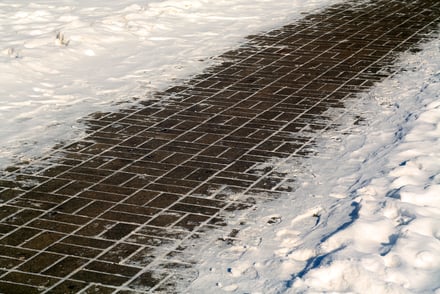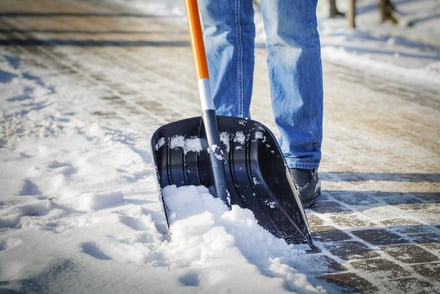As the snow begins to fly and ice forms on the eaves, the perennial controversy about the best ice and snow treatment for brick walkways and steps. Clearing ice and snow from bricks is important not only for the safety of the household but also for mail carriers, delivery people, and wintertime visitors.
DC homeowners are responsible for clearing the sidewalks in front of their homes. If those are brick, as many are in historic neighborhoods, special care should be given to them as well. Each year homeowners need to weigh the benefits and disadvantages of various methods available to clear the walks.
Shoveling – The Free Workout
Clearing away snow and slush as it accumulates is one of the best ways to prevent the buildup of ice while protecting the integrity of your outdoor masonry. In the case of light snow, it may even be possible to keep it cleared with the quick sweep of a broom. The exchange for this more labor-intensive method is the better preservation of bricks and lower long-term costs in maintenance and repairs. Best of all, your brick and masonry walkways will thank you by holding up and retaining their beauty through all the seasons for years to come.
Sand – the Gritty Truth
Once cleared as much as possible, sand offers a natural solution to slipperiness while aiding in the preservation of masonry. It is often used in the placement of pavers, and filler that has washed or blown away can be replaced when keeping the ice at bay. When the weather has cleared, excess grit may be swept up, collected, and used again for the same purpose.
The Price of Salt
Another conventional approach for quick melting and drying action on potentially dangerous walking surfaces is to use salt mixed with sand. This combination helps melt the ice and snow while providing traction, but the salt will have a corrosive effect on masonry. If this is the method you choose, it’s best to use it sparingly and clear away any excess as soon as it is safe to do so.
A Chemical Solution
In contrast to labor-intensive shoveling, the other end of the spectrum brings us to products labeled as, “ice melt.” Homeowners may choose this option if they cannot remove snow manually or need a rapid solution to mitigate risks. Just as with salt, these products, even those labeled, “safe for pets and people,” will damage your brick and masonry materials over the course of the season. If this is the product you choose, remove all traces of the whitish residue that appears once the bricks are cleared.
Overall, shoveling and sand are the preferred methods to remove snow and ice while safeguarding a home’s exterior masonry. Other options may not cause it to crumble immediately, but a season or two will bring cracks, spalling, and mortar disintegration. All these can be fixed, but the cost and inconvenience of repair or replacement may outweigh the advantages of clearing ice and snow more quickly a few times each winter.
Whichever treatment you choose, make good use of doormats or boot scraping devices at your doorways to limit the amount of sand or salt tracked into the house.
If your brick or exterior masonry surfaces have already suffered the effects of repeated ice and snow treatments, it may be time to consider replacing or upgrading them once the warm weather returns. Winter is a great time to contact Renaissance Development to schedule your spring exterior masonry projects.
Dec 23, 2021 9:00:00 AM

